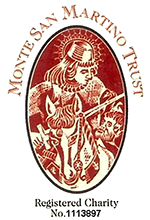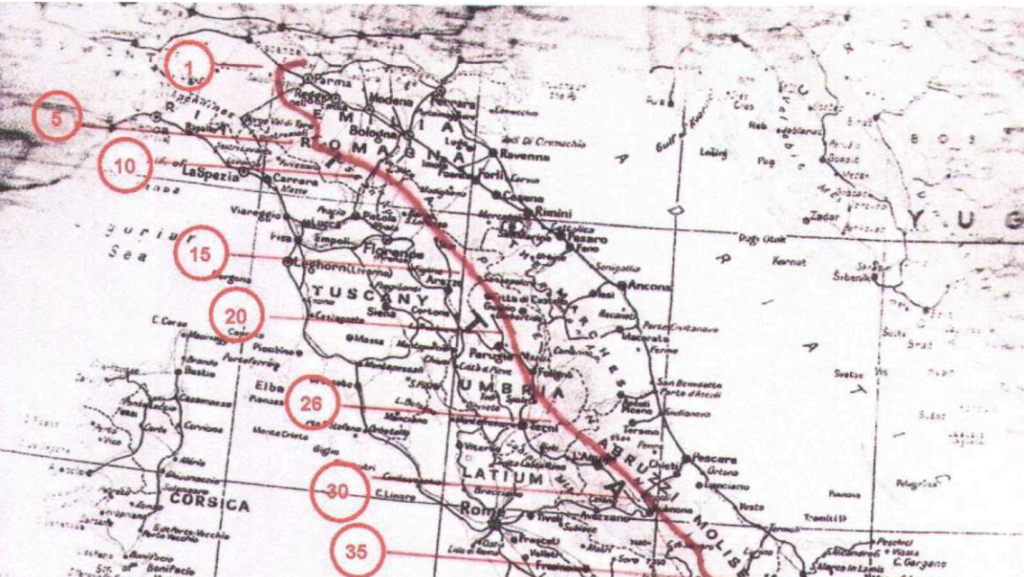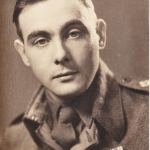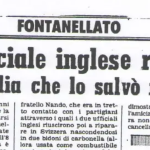Summary
Account by Virgilio Panozzo, an Italian, whose family, in Tresche Conca, hid British soldiers and helped them to escape from the Germans. Virgilio met members of the English mission code named Fluvius.
After the war Virgilio was summoned by the English Authorities who presented him with money and a certificate which would allow him to move to any country in the Commonwealth. He moved to Australia in 1956, met up with his former girlfriend, Floriana, found work as a draftsman, and found that his certificate would stand him in good stead.
The full story follows, in two versions. The version in the first window below is the original scanned version of the story. In the second window below is the transcribed version in plain text.
Towards the end of 1943, some German cars with soldiers aboard were making daily visits to the hills surrounding the area of Tresche’ Conca, a little town on the plateau of Asiago, in the province of Vicenza, my town. They never came into the village but surveyed the hills facing the plains of the Po valley.
I was keen to know what they were up to and one day I decided to find out.
(It was only years later that we found out that those soldiers were the so called “Geologists of Himmler” and that they had been surveying the area in preparation for the construction of a new line of defence, called the “Blau Linie”, as the last bastion in case of the collapse of the Gothic Line).
I put on my skis and left home in the direction of Monte Cengio via Val di Gievano and the little hill known as Forcella, so as not to encroach on the route followed by the Germans.
On the way up from the valley to the Forcella I went past a very deep depression at the bottom of which was a dilapidated cowshed with dry stone walls and a rusty metal roof.
I knew the area well from the time when I was minding my family’s herd in the valley during the summer months and was surprised to see four young men sitting in the sun in front of the shed and reading books.
I knew that the shed was only used from the end of September to mid-October when the cows were taken there back to the plains after spending the summer grazing on the higher mountains.
After 8th September (the Italian Armistice) even the mountains of Asiago had become the place of abode for young people from the cities and the plains who refused to listen to the serenading of the Fascists and the Germans, inviting them to join the new army (of the Republic of Salo`) and continue the fight against the Allies who were gradually advancing from the south of Italy.
They became the backbone of the partisan groups that fought both the Fascists and the Germans until the collapse of the Gothic line and their defeat in April 1945.
I could not resist the temptation of finding out who those young men were and I went down the slope and approached them with the salute of “Buon Giorno”.
One of them replied, and his accent told me that they were strangers. I asked where they had come from. The answer was “Milano” in a clear English accent. That confirmed what I had suspected.
I assured them that I would not do anything against them and attempted a bit of conversation in English. I soon realised that my English was just as good as their Italian. I knew my grammar but I needed practice. We still managed to get by.
Not to be seen or heard by anybody, we went inside the shed and there they told me the bit of their story they could tell me: they were British soldiers taken prisoners in north Africa and interned in a camp near Verona. They had escaped after 8th September 8, when Italy had surrendered, and had been moving around the countryside ever since, assisted by many “unknown” helpers. No names were divulged in those days.
They had left their last hiding place only a few days earlier to avoid being caught by the Fascists or the Germans and had lost contact with their last benefactors.
Their supplies were running short and they were considering a visit to the nearest town after having investigated whether there was any danger of being caught.
Two of them were English: Pat, from Plymouth, and Norman, from Hull, and two were New Zealanders: Richard and Lloyd, the latter part-Maori, from the North island.
I assured them that they had nothing to worry about from me and promised to assist them. I would return as soon as possible with fresh supplies, possibly the same evening after dark. We selected a password and parted company.
I had lost any interest in why I had left home only a couple of hours. When I arrived home, I told my parents the story and they agreed with me that it was our duty to help those men: they were people caught by events which had nothing to do with them personally and they had mothers or wives to return to once the war was over.
We spoke about the fact that my older brother, Carlo, had not arrived home after 8th September and was still in south Italy. Maybe somebody was looking after him just as we intended to do with these four soldiers.
Food was then scarce and controlled by the authorities but we decided that we would help just the same.
That evening I returned fully loaded with supplies as promised. When I approached the shed and called out for them with the password, the light of the moon on the snow allowed me to see shadows running in all directions. I repeated my call and they all came back, albeit one by one and at intervals.
The old building was divided into two sections, with one for the cows and the other for the people minding them. The living quarters had an upper floor room for sleeping. The room at ground floor level was used as a kitchen-dining room with the cooking carried out in an open fireplace.
The upper area of the stable was used for keeping straw and dry leaves of beech used for litter. Occasionally this area was used also as sleeping quarters.
The evening was spent talking about our families and the war in front of the fire. My English was then very shaky and the conversation opened up for me a new horizon.
It was about two o’clock in the morning when I set of for home and that pattern was repeated for the rest of the month. After a couple of weeks I moved the escapees to a new site further away from town to avoid them becoming too conspicuous and to avoid the geologists who were getting too close for comfort.
For the next three months the routine was: leave home at around eight o’clock at night and return home after three o’clock in the morning. At least three hours of that time were spent on a dangerous track between the open trenches of the first world war and the cliffs of the Valdassa.
Since food was scarce I approached some of our relatives and neighbours and they were all happy to contribute as much as they could. The Germans did not have any friends in my little town at that time.
At the end of April 1944 the soldiers left the area together with a group of partisans to avoid the raids being systematically carried out by the Fascists and the Germans.
Before their departure they left me a letter in which they stated their names, their family addresses, their army particulars and what I had done for them and recommended I should present it to the Allied Authorities once they reached the area.
I put that letter in a small bottle, sealed it with wax and buried it under the stone step leading from the courtyard to our vegetable garden.
Since I was still a minor (I turned 17 four days after I had met Norman and his companions) I had no obligation to join the army and was free to move around, with caution because the Germans knew that the partisans were using the young boys and girls as couriers to deliver their messages.
Some time after the departure of the four escapees I heard a whisper that somebody was investigating my life and intended to report my activities to the Germans.
To avoid any harassment of my family, I left home and joined the group of partisans which I had helped to set up a few months earlier and stayed with them until the end of the war.
The person in question never carried out his threat as he met his early fate while still investigating the rumors about the English prisoners. He had been successful in having two Australians prisoners recaptured in November 1943 but this time luck was not on his side.
In September 1944 I had the opportunity to meet members of the English mission code-named “Fluvius”, who had been parachuted into the area in August to organise partisans for the final push programmed for September. Major John Wilkinson (Freccia ) was the head of the mission; the other English members of the team were Lieutenant Christopher Woods (Colombo) and Corporal Douglas Archibald (Arci).
At the end of the war, I presented my letter to the American governor in Vicenza.
At the same time I wrote to my old friends and within a short time I received their reply: Norman, Pat and Richard had returned home, but Lloyd had been killed by the Germans in August 1944 while trying to get into Switzerland.
In October 1946, I received a letter from the English authorities requesting me to attend a meeting in the town hall of Asiago on 2nd December: an officer of the British army would be there and he would issued a certificate and some money to the people who had helped British prisoners on the run.
The English captain who presided at the meeting stated that the document we were receiving would be a sort of safe conduct in case we decided to move to any country of the British Commonwealth.
With the money I received I was able to resume my studies and gain admission to the University of Padua.
In 1956, answering a special call, I decided to migrate to Australia. I left Genoa on the 23rd August 1956 reaching Melbourne on 20th September and Adelaide on the 22nd after a 14-hour train journey. At the railway station of Adelaide Floriana, my girlfriend, was waiting for me and after four years we were once again together.
On 25th September, I went to the main office of the Architect-in-Chief to apply for a position as a draftsman. I was told that there was a vacancy but that I had to undergo a test.
The test was organised for the afternoon and I returned home to have lunch and to collect my drafting tools. On arrival, I found that Floriana had a letter in her hands for me from Italy, written to me by a very dear friend. He informed me that my father had passed away while I was sailing across the ocean.
I do not intend to dwell on the thoughts which went through my mind. The one memory of my father which came back to me more strongly than the others was that one day he had told us that no matter what happens to any of us, life has to continue its normal process.
With that thought in my mind, I collected my tools and went for my appointment. When I arrived at the office, I was assigned a place to sit and without much fuss I was asked to reproduce the drawings of a job already under construction.
Fortunately, before I left Italy I had familiarised myself with the imperial system of measurement and the task was not difficult at all.
During the afternoon one of the draftsmen noticed that I was frequently wiping my eyes and, thinking that I was having some difficulty, he offered his assistance. Once I told him about the letter he offered his condolences and returned to his desk.
Soon after, all the other members of the staff, one by one, came to see me and offered their condolences
By five o’clock the test was over. The supervising architect told me that he was very satisfied with my performance and that he would recommend me to the Public Service Commissioner for the position. The only thing left for me to do was to wait for that notification from the Public Service Commissioner.
Every morning for the next two weeks I waited for the postman with my heart beating very fast but nothing ever arrived.
I decided to pay a visit to the supervising architect to find out something about the situation only to be told to be patient because the person responsible for my employment was on sick leave.
Nearly another two weeks went by and at the end of that period I decided to try my luck by approaching directly the Minister of Works, the minister responsible for the Architect-in-Chief’s department, to see whether he could help.
On the morning of Friday 19th October I went to the office of the Minister of Works and asked his secretary whether I could see the minister. I told her that I had no appointment but I had an urgent need to talk to him and I told her my story. She took a few notes and then entered the minister’s office,
When she came out she said that the minister had very little time but that he would see me before he attended the cabinet meeting that morning. Soon after, the minister appeared at the door and invited me to enter his office, calling me by name.
He invited me to sit down and to tell him my problem. When I finished, he gave me the same answer I had received earlier from the supervising architect.
I pointed out to him that the few savings I had taken with me from Italy were dwindling and that I was considering leaving Adelaide for Broken Hill, where I could find employment in the mines. He suggested that I not do that because the position was mine, but the answer was still the same.
It was then that I decided to make use of the promise of 2nd December 1946 in Asiago and I produced the document handed to me then by the English captain.
After a quick look at the paper the minister stood up and saluted me militarily and then walked around the desk stretching his hand: we shook hands and then he embraced me, showing clear signs of emotion.
He soon recomposed himself and justified his emotion by saying that he had been a prisoner of war in the hands of the Japanese but that he had not found a Good Samaritan.
He called in his secretary and asked her to get us a cup of coffee. In the brief conversation that followed he told me to relax and to go home: by early next week I would receive the letter with the confirmation of my appointment.
When I queried the position of the Public Service Commissioner, he replied: “He will countersign my signature.”
We parted company and I went home to celebrate with Floriana.
With the mail of the Monday afternoon the letter was in my hands and the morning after, Tuesday 23rd October, I started my career as a public servant in the Architect-in Chief’s department.
From then on, the minister took a particular interest in me by checking out whether I was happy in the service and by first convincing me, and then assisting me, to enrol in the faculty of architecture of the South Australian Institute of Technology, now the University of South Australia
The way was open for me and Floriana, the real reason for my migration to Australia, to start thinking seriously about our wedding.
We were married on 6th May 1957 and on 14thJanuary 1958 our first son, Domenico, now a medical practitioner, was born. He was followed by Carlo, an architect, Andrea (Andrew) a school teacher, and Caterina, a social worker.
In 1963, I completed my studies qualifying as an architect and continued in the service until my retirement on 31st March 1987, having reached the level of Senior Architect class 3.
Soon after my retirement I travelled to Italy. When I visited the site of the refuge of the four escapees the only things still visible were the pavement of the stable and the hearth of the old fireplace. All the stones of the old building had been used in the walls of a new holiday home built only a few metres away.
Virgilio Panozzo



